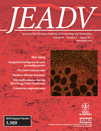Subcutaneous injection of liquid and foamed polidocanol: extravasation is not responsible for skin necrosis during reticular and spider vein sclerotherapy
Conflict of interest None declared.
Funding source None.
Abstract
Background Cutaneous necrosis is one of the most annoying complications of reticular and spider vein sclerotherapy. The precise incidence of the complication is not known, although various sources reported incidence between 0.2% and 1.2%. Among a few mechanisms proposed to explain it, extravasation of the sclerosant into the perivascular tissue has been cited as the major cause.
Objectives The aim of the experimental study in rats was to examine the potential of various concentrations and volumes of polidocanol in both liquid and foam forms to cause cutaneous necrosis after superficial subcutaneous injection.
Methods Twenty-four female Sprague Dawley rats were injected subcutaneously different concentrations (0.5%, 1%, 2% and 3%) of polidocanol as well as different preparations of polidocanol (liquid vs. foam) and volumes (0.1–0.5 mL). The animals were sacrificed 10 days after injections and biopsy specimens were obtained.
Results Cutaneous necrosis was not seen at volumes <0.5 mL regardless of the concentration or form of polidocanol injected. Foam preparation was shown to be less potent in inducing necrosis with a minimal strength being 2% in comparison with the liquid form where 1% was sufficient to produce overt cutaneous necrosis.
Conclusions This experimental study shows that extravasation of polidocal in usual circumstances of sclerotherapy of spider and reticular veins cannot be a significant cause of cutaneous necrosis rarely observed in this setting. It is particularly true for the foamed polidocanol where 1% strength seems safe if injected extravascularly in volumes up to 0.5 mL.




